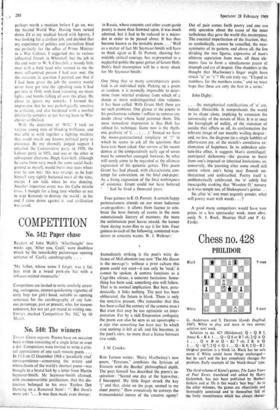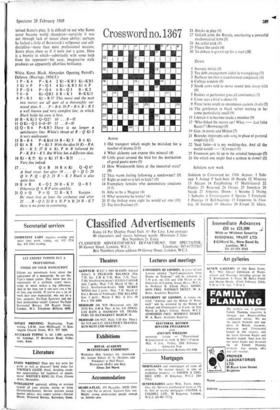Chess no. 428
PHILIDOR
Black Wl 9 men 9 men G. Andersson and S. Ekstrom (Lunds Dagblad. 1947). White to play and mate in two moves; solution next week.
Solution to no. 427 (Shinkman): Q - Q B 1.
threat K R4. 1 Q - Q 8 or B 7 ch; 2 Q X Q. 1 . . .Qx BorQ- Kt 7 ch; 2 K X Q- 1 Q - Q 7; 2 Q x Q. 1 Q - K 8; 2 Q - B 2. Original position is a block i.e. Black has no safe move if White could leave things unchanged— but he can't and the key completely changes the problem. Early example of the 'block-threat' type.
The third volume of Keres's games, The Later Years of Paul Keres. translated and edited by Harry Golombek, has just been published by Herbert Jenkins and at 35s is this week's 'best buy.' As in the other volumes, the games are objectively and thoroughly annotated and in themselves full of the lively inventiveness which has always charac-
tensed Keres's play. It is difficult to say why Keres never became world champion-certainly it was not through lack of innate chess ability; perhaps he lacked a little of Botwinnik's willpower and self- discipline-more than most professional masters, Keres plays chess as if it were just a game. Here is a brevity in which-admittedly with some help from his opponent-his easy, imaginative style produces an apparently effortless brilliancy.
White, Keres. Black, Alexander. Opening, Petroff's Defence. (Hastings, 1954/5.) 1 P- K4 P-K4 2 Kt-KB 3 Kt-KB3 3 Kt x P P-Q 3 4 Kt-KB 3 Kt X P 5P-Q4 P-Q4 6 B-Q 3 B-K 2 7 0 - 0 Kt-QB3 8 R -K 1 B-KKt5 9 P - B 3 Kt - B 3? This move and the next two moves are all part of a thoroughly un- sound plan. 9 . . . P - B 4; 10 P - B 4. 8 - R 5 a well known and very complex line, in which Black holds his own, is best.
10 B - K Kt 5 Q-Q2? 10 . . . 0 - 0!
11 Q Kt - Q 2 0-0-0? 11 . 0 - 01 12 Q- R 4 P-KR 3 There is no longer a satisfactory line: White's threat of B - Q Kt 5 is very unpleasant.
13 B - R 4 P-KKt4 14 B - Kt 3 B x Kt 15 Kt x B P - Kt 5 With the idea 16 Kt - R 4, Kt - K 5; 17 B X Kt, P X B followed by P - K B 4 - B 5. But White has a different idea.
16 Kt - K 5! Kt x Kt 17 B - B 5! . . . Very fine indeed.
17 . . . Q x B 18 R X Kt Q -Q 6? A final error, but after 19 . . . Q - Q 2; 20 Q x P. Q - Q 2; 21 R - K 3 Black is also quite lost.
19 R X B R-Q 2 20 R-K 3! Q-R 3 Otherwise Q x RP wins quickly.
21 QxQ PxQ 22 B-K 5 Resigns He must lose at least the exchange and after 22 . . . R - Q 3: 23 B x R, P X B: 24 R - K 7 there is no point in continuing.



































 Previous page
Previous page